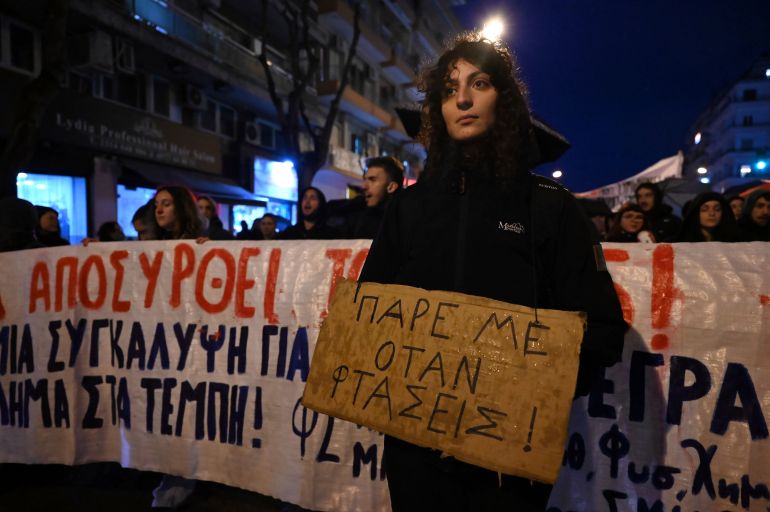The station master involved in Greece’s worst-ever train disaster will appear in court on Saturday, as mass protests broke out over the crash that killed at least 57 people.
Thousands of protesters have demonstrated across the country since Tuesday’s collision between a passenger train and a freight train, with public anger mounting over the government’s failure to manage the rail network.
The 59-year-old station master at Larissa, central Greece, has admitted responsibility for the accident, which saw the two trains run along the same track for several kilometres.
The train was carrying many students returning from a holiday weekend and at least nine young people studying at Thessaloniki’s Aristotle University were among the dead, while another 26 were injured.
Prime Minister Kyriakos Mitsotakis, who is seeking re-election this spring, has blamed the disaster on “tragic human error”.
But protests blaming government mismanagement continued on Friday in the capital, Athens, and several major cities across Greece, with more planned for the weekend.
“What happened was not an accident, it was a crime,” Sophia Hatzopoulou, 23, a philosophy student in Thessaloniki who was visibly angry, told the AFP news agency. “We can’t watch all this happen and remain indifferent.”
She added that she and her classmates “knew people who were killed or wounded”.
“It’s as if a part of us were lost.”
The station master is due to appear in court on charges of negligent homicide. He faces life imprisonment if found guilty, but his lawyer has argued that other factors were at play.
“My client has assumed his share of responsibility,” lawyer Stefanos Pantzartzidis said on Thursday. “But we must not focus on a tree when there is a forest behind it.”
The country’s public broadcaster ERT reported that the station master had been appointed to the post only 40 days earlier – and after just three months’ training.
Thousands gathered on Friday outside the Athens headquarters of operators Hellenic Train – which took over network operations in 2017 – to protest at decades of failure to improve rail network safety, despite close calls in past years.
Hundreds of people observed a minute of silence outside the Greek parliament in tribute to the victims of the disaster.
At the rally in Syntagma Square, adjacent to parliament, officers fired tear gas and stun grenades at protesters throwing stones and Molotov cocktails, an AFP reporter said. About 3,000 people turned out for the demonstration.
A similar number demonstrated in Thessaloniki – Greece’s second largest city – where police had reported clashes on Thursday with demonstrators throwing stones and petrol bombs.
Demonstrations also took place in other Greek cities on Friday: about 700 turned out in Larissa, the town closest to the site of the disaster, while 500 demonstrated in the university town of Patras in the southwest Peloponnese, according to police.
Roubini Leontari, the chief coroner at Larissa’s general hospital, told ERT on Thursday that more than 10 people were still unaccounted for, including two Cypriots.
Greece’s train services were paralysed on Thursday by striking workers arguing that successive administrations’ mismanagement of the network had contributed to the fatal collision.
That strike continued into Friday and is set to continue for another 48 hours.

Rail unions say safety problems on the Athens-Thessaloniki railway line had been known for years.
Legal sources suggested that investigators were considering criminal charges against members of the management of Hellenic Train.
Police seized audio files and other items during a raid on the Larissa train station in central Greece, where the crash happened, a judicial source said.
For decades, Greece’s 2,552km (1,585-mile) rail network has been plagued by mismanagement, poor maintenance and obsolete equipment.
After the country’s transport minister resigned on Wednesday in the wake of the crash, his replacement, Giorgos Gerapetritis, promised a “complete evaluation of the political system and the state”.
Safety systems on the line are still not fully automated, five years after the state-owned Greek rail operator TrainOSE was privatised and sold to Italy’s Ferrovie dello Stato Italiane and became Hellenic Train.
Source : Al Jazeera


